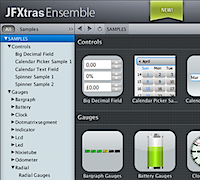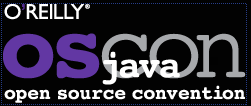You are currently browsing the tag archive for the ‘Open Source’ tag.
Tag Archive
Android “open for embedded”? Part 3
11/28/2013 in Embedded | Tags: Android, embedded, Java Embedded, Open Source | 1 comment

Google is moving quickly to further lock down the Android ecosystem (as already reported in part 1 and part 2).
Yesterday, cyanogenmod was forced by Google to remove the CyanogenMod Installer from the Google Play Store, citing that it ‘encourages users to void their warranty’. However, if you know that cyanogenmod is working with hardware manufacturers to preinstall CyanogenMod to create alternate Android devices then Googles demand appears in a very different light.
I expect the next step for Google is to start locking down side-loading as well (installing apps through alternate channels) to further tighten control.
The air for embedded Android is getting thinner.
Cheers,
— Terrence
Android “open for embedded”? Part 2
11/20/2013 in Embedded | Tags: Android, embedded, Java Embedded, Open Source | Leave a comment

A few weeks ago I blogged about an ars technica article which looked at Google’s increasing control over the Android ecosystem (“Android “open for embedded”? Must-read Ars Technica article”).
Yesterday, Vision Mobile published a related post “The Naked Android” which keenly describes the role of Google Play Services and how Google is driving towards its Android endgame of “flatten, expand, mine”.
More food for thought if you’re considering Android for embedded.
Cheers,
— Terrence
Android “open for embedded”? Must-read Ars Technica article
10/23/2013 in Embedded, Mobile & Embedded | Tags: Android, embedded, Java Embedded, Open Source | 3 comments
Update (Nov 20): See also part 2 of this post.
A few days ago ars technica published an article “Google’s iron grip on Android: Controlling open source by any means necessary”.
If you are considering Android for embedded this article is a must-read to understand the severe ramifications of Google’s tight (and tightening) control on the Android technology and ecosystem.
Some quotes from the ars technica article:
- “Android is open – except for all the good parts“
- “Android actually falls into two categories: the open parts from the Android Open Source Project (AOSP) … and the closed source parts, which are all the Google-branded apps”
- “Android open source apps … turn into abandonware by moving all continuing development to a closed source model.”
- “Joining the OHA requires a company to sign its life away and promise to not build a device that runs a competing Android fork.”
- “Google Play Services is a closed source app owned by Google … to turn the “Android App Ecosystem” into the “Google Play Ecosystem”
- “You’re allowed to contribute to Android and allowed to use it for little hobbies, but in nearly every area, the deck is stacked against anyone trying to use Android without Google’s blessing“
Compare this with a recent Wired article “Oracle Makes Java More Relevant Than Ever”:
“Oracle has actually opened up Java even more — getting rid of some of the closed-door machinations that used to be part of the Java standards-making process. Java has been raked over the coals for security problems over the past few years, but Oracle has kept regular updates coming. And it’s working on a major upgrade to Java, due early next year.”
Cheers,
— Terrence
JFXtras Project: More cool features for your JavaFX app
06/15/2012 in Mobile & Embedded | Tags: JavaFX, JFXtras, Open Source | 1 comment
JFXtras in an open source project that provides a bunch of interesting components and pieces to make your JavaFX application even more productive, engaging, and, yes, sexy. And saves you coding time along the way.
Check out the new JFXtras Ensemble demo, which showcases in one fell swoop all the features and bits you can take advantage of. Also, bookmark Jim Weaver’s excellent blog to keep up with all things JavaFX and rich client.
Cheers,
— Terrence
Open sourcing of JavaFX: OpenJFX Project proposed
11/02/2011 in Mobile & Embedded | Tags: JavaFX, Open Source, OpenJDK | 1 comment
 A few weeks ago at JavaOne, Oracle announced its intention to open source the JavaFX platform.
A few weeks ago at JavaOne, Oracle announced its intention to open source the JavaFX platform.
To that effect, Oracle yesterday proposed to the OpenJDK mailing list the creation of the OpenJFX Project as the home not only for the JavaFX source code, but also for current and future development of the JavaFX toolkit in an open development model.
This is a significant step for the JavaFX technology and the OpenJDK project and demonstrates quite clearly Oracle’s commitment to open source, transparency, community building, and the success of JavaFX.
Some info on the planned OpenJFX contribution:
- Over 6000+ public API members (methods/constructors/etc.)
- Over 11,500 unit tests
- Core libraries such as observable collections and binding
- Scene graph, effects, graphics
- CSS support for JavaFX
- Media
- WebView
- Prism (hardware accelerated graphics, including openGL and D3D and java2D implementations)
- Glass (windowing system, base porting layer, including mac, linux, and windows implementations)
- UI Controls and Charts
More background information can also be found on the FX EXPERIENCE blog.
Cheers,
— Terrence
JavaOne 2011: First Wrap-Up
10/06/2011 in Mobile & Embedded | Tags: embedded, Embedded Java, emeb, Java 7, Java EE, Java language, Java ME, Java on OS X, Java platform, Java SE, Java SE 7, Java SE 8, Java SE Embedded, JavaFX, JavaOne, JavaOne San Francisco, mobile, Mobile Java, Mobility, Open Source, OpenJDK | Leave a comment

Finally, I get a chance to catch my breath. JavaOne has been extremely busy and while there are still a few hours of good talks to go here is a quick summary so far:
General observations:
The vibe is very positive. Attendance is significantly up over previous years and the show is well organized. Feedback from attendees has been very excouraging – lots of good buzz on #javaone and other social channels. Many sessions are sold out or standing-room only.
Announcements:
This year’s JavaOne left no doubt Java is moving again, and picking up steam. Throughout the conference and in the various keynotes there was a host of announcements, strategic initiatives, roadmaps, product releases and updates.
I’ll try to summarize, focusing on the Java Platform, Java SE, and Java ME technologies:
Java SE and the Java Platform:
- Oracle announces plans for advancing the Java SE Platform, including a vision beyond JDK 8
- A JDK 7 for Mac OS X Developer Preview is now available, with full developer and consumer releases planned for 2012
- NetBeans 7.1 Beta is now available, featuring full Java SE 7 support
- Oracle details plans for JDK 8, proposed features, and a revised roadmap with extended scope, now scheduled for availability in summer 2013
- Oracle is continuing its work to merge the HotSpot and JRockit JVMs, with the first converged features available in JDK 7
- IBM announces availability of Java SE 7 across its products lines, the faster ever adoption of a new Java SE release by IBM
- Oracle recently announced availability of Java SE 7 for Embedded on ARM and x86 platforms
OpenJDK:
- OpenJDK hosts the development of JDK 7 for Mac OS X, JDK 8, and becomes the reference implementation for Java SE 8 and beyond
- Twitter joins OpenJDK
JavaFX and Rich Client UI Technology:
- The JavaFX 2.0 GA for Windows is now available
- A JavaFX 2.0 for Mac OS X Developer Preview is now available, with GA releases planned starting 2012
- NetBeans 7.1 Beta is now available, with JavaFX 2.0 support
- Oracle details JavaFX roadmap to 2013, including cross-platform support for Mac OS X and Linux
- Oracle announces plans to open source the JavaFX platform in the OpenJDK project
- A private Beta for JavaFX Scene Builder is now available, with public Beta planned in early 2012
- Oracle announces Project ‘Avatar’: A complete solution for Dynamic Rich Clients, including HTML5 support and back-end integration
Java ME:
- Oracle increases investment in Java ME
- Oracle Java Wireless Client (OJWC) 3.1 is now available
- Oracle announces plans to evolve the Java ME Platform and align Java ME with Java SE 7 through:
-
- Submission of new JSRs over the coming months
- Updates of the CLDC Platform VM and library specifications to enable better alignment with Java SE 7 features
- Creation of a “CDC Profile” in Java SE 8, which allows deployment of Java SE 8 implementations in resource-constrained environments
- JavaFX to become the graphics framework of choice for mid-range and high-end embedded platforms
- Oracle announces intent for full coverage of embedded vertical markets
- Oracle plans increased and deeper integration of Java ME with content services (“Mobile Services Integration”)
For more information and details, please see the related press releases:
- Oracle Continues to Move Java Forward and Details Java SE 8 Roadmap
- Oracle Highlights Java EE Momentum at JavaOne Conference
- Oracle Releases JavaFX 2.0
- Oracle Increases Investment in Java ME
- Oracle Announces Winners of the 2011 Duke’s Choice Awards
- Oracle Previews NetBeans IDE 7.1: Delivers Support for JavaFX 2.0
Summary
After speaking to many developers over the past days it’s clear JavaOne has brought renewed excitement and energy to the Java community. I personally am particularly excited about Java FX 2.0, the Mac OS X support for JDK 7 and JavaFX, and bringing Java ME back to the mainstream platform again.
Two more related links:
- JavaOne celebrates the success of enterprise Java (InfoWorld)
- Oracle shows JavaFX on iOS and Android (MacWorld)
Cheers,
— Terrence
OSCON Java 2011: Video Highlights
08/08/2011 in Mobile & Embedded | Tags: Java, Open Source, OpenJDK, OSCON | Leave a comment
Yes, I know, I’m a bit late (I was on vacation for a week) – OSCON is already over. I didn’t attend myself but I heard there was a lot of good content at OSCON Java – some of which is already published on YouTube.
Here are just a few of the ones I found interesting (and I’m sure there’s more):
- Patrick Curran: “Who needs Standards?”
- Jim Weaver: “JavaFX in the Real World”
- Bob Lee: “On the Cusp of a Java Renaissance”
- Josh Bloch: “Java: The Good, Bad, and Ugly Parts”
- Steven G. Harris: “Open Source, Java, and Oracle – Cracking the Code”
Enjoy!
Cheers,
— Terrence
Java 7 Launch + Events
07/04/2011 in Mobile & Embedded | Tags: Java, Java 7, Java SE 7, JDK 7, launch event, Open Source, webcast | Leave a comment
 Java 7 will be launched this Thursday, July 7, 2011. This release puts Java back on the tracks with a host of new features and improvements, moving Java 7 forward for developers, the industry, and the ecosystem.
Java 7 will be launched this Thursday, July 7, 2011. This release puts Java back on the tracks with a host of new features and improvements, moving Java 7 forward for developers, the industry, and the ecosystem.
To learn about this new release, please join us for the Java 7 Launch Event, held simultaneously in California, Brazil, and the U.K.:
- Redwood Shores, CA, USA (Thursday, 9:00 am PT)
- Sao Paulo, Brazil (Thursday, 1:00 pm BRT)
- London, UK (Thursday, 5:00 pm BST)
or attend one of the many Java 7 events around the world, organized by local Java User Groups (JUGs). Find your local JUG here. For a list of JUG events see The Java Spotlight Podcast episode #37 (planned for publication tomorrow, July 5th).
If you can’t attend an event in person you can view the webcast by registering:
Cheers,
— Terrence
OpenOffice moves to Apache, JTHarness 4.4 released
07/01/2011 in Mobile & Embedded | Tags: Apache, JT Harness, Open Office, Open Source, testing | Leave a comment

Back from vacation, catching up with open source news:
- Open Office has moved to the Apache Incubator. Check out Christian Grobmeier’s blog for more information.
- JTHarness is an open source, general-purpose, full-features, flexible, and configurable test harness. Version 4.4 was released a few days ago and adds a few new features as well as a number of bug fixes. See the JTHarness project page for more information.
Cheers,
— Terrence
Google Analytics API for Java ME
05/05/2011 in Mobile & Embedded | Tags: Analytics, Android, Java ME, Mobile Java, Open Source, Project Kenai | Leave a comment
 Ernandes Mourao Junior is cranking out good stuff. A while ago I blogged about his excellent Twitter API ME project – I’ve used it myself and it works very well.
Ernandes Mourao Junior is cranking out good stuff. A while ago I blogged about his excellent Twitter API ME project – I’ve used it myself and it works very well.
Among other things he is working on, Ernandes now has released the Google Analytics ME API.
Quote:
Google Analytics ME is a compelling and well defined API for Java ME and Android developers who wish to integrate their apps into Google Analytics. With this API, developers will be able to prepare their apps to send out useful data, about how users are interacting with them. Those data will be valuable to identify, e.g., audience and improvement points.
The project page has a few introductory code snippets, the code itself, as well as links to further documentation on Google Analytics. Looks pretty straightforward – I hope to be able to give this a spin soon.
Thanks, Ernandes – and keep up the good work!
Cheers,
— Terrence



Recent Comments